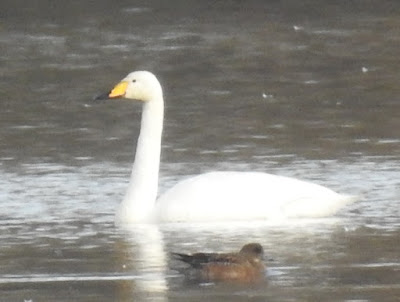Having said this, I've actually had my second best January ever, reaching 79 species by the month-end, only surpassed in 2016 when I had 82. I'm three ahead of last year at this stage, though it's a bit of swings and roundabouts until Spring passage kicks in.
Best bird by a country mile has been a Whooper Swan. This adult bird arrived during the afternoon of the 30th. It had not been seen during my morning round or Alan S's early afternoon round, but was found by Mike M at about 1:30pm. I couldn't get back to site until 3pm, but found the bird on the far east side of the spit swimming up towards the works bay. This is about as far away from any lake edge that you can get and coincidentally is exactly the area chosen by a family party of Bewick's Swans back in December 2010. There were obvious assumptions being made that this was the same adult bird of unknown origin that had graced the patch almost daily from late June last year until early/mid October when it disappeared. However, even though I could only get distant record shots, the appearance of both birds seems different, most notably the pattern of yellow on the bill and the shape of the bill. Whilst watching the swan, it was also interesting to note how alert, yet tired, it seemed: alert in that it was constantly swimming with upright neck, but also kept closing its eyes as if trying to rest. Coupled with the fact that it remained to at least 3:45pm but was not seen the next day or again, here or locally, led me to give this bird the benefit of the doubt. So a great way to round off January with an ultra rare patch bird (I'm not even sure that it was on the site list!) and a patch tick.
 |
| Heavy crop, as distant |
 |
| Even heavier crop to show detail of bill |
 |
| Last year's bird for comparison. Note the apparent differences in bill pattern and structure |
Other good January birds were a Dunlin on the 9th. I watched this bird fly in to the spit mid morning, though there were apparently three birds by mid afternoon, so obviously a few flying around that day; a fly through Peregrine on the 22nd and a Cetti's Warbler on the 30th. I was particularly pleased to see the Cetti's, as there had been one (and two for a while) around since last summer, but I hadn't seen or heard one since mid December. I am hoping that with the increased sightings over the past couple of years that they are on the verge of colonising.
Other than that, as I noted at the start, it has been usual January fare. No unusual ducks yet, though I managed to miss two separate records of Pintail, a four and a two on two dates. Shelduck probably the best and being seen on most visits, with up to three birds, a pair and a separate male.
I had a nice visit to the farmland part of my patch on 5th Feb and added a further three species for the year. The game cover has been cut down recently and attracted a large flock of finches. I watched them flying between the hedgerow and the stubble to feed on fallen seeds. There were in excess of 150 Chaffinches and amongst them, 2-3 Brambling, about 10 Yellowhammers and a few Reed Buntings. The usual Winter flock of Linnets was also present and numbered around 90 birds. It was also nice to see two Grey Partridge following the birds I saw last year. I think I was a bit harsh on those in not counting them on my list, as even if they have been released, which is not definite, they are at least as worthy as all the Red-legged Partridges and Pheasants that I merrily count each year, so I have upgraded them this year and ought to do a retrospective 'add 1' to last year's total.
I also saw a nice 1st winter Yellow-legged Gull loafing with a group of Herring Gulls on the 5th. It was rather a smart looking bird, a shame that my record photo is a bit over exposed in the bright sunlight to do it proper justice.
So that's about it so far in 2018. I'm on 83 for the year, which is my quickest to this total since I started keeping accurate year lists in 2014 (the start of patchwork challenge). There is still time to get some the scarcer Winter birds before Spring kicks in, but there a few gaps this year - Woodcock is looking doubtful as the regular roosting birds we used to get seem to have deserted since the mass felling of trees on the north side; I haven't come across any wintering Chiffchaffs this year (unusual), which doesn't bode well for picking up Siberian Chiffchaff, which has shown up in three of the last four years; I haven't seen or heard any owls yet, though hopefully at least two species will show up sooner or later - I think Little Owl is no more, unfortunately, my last record on patch was from 2014.





No comments:
Post a Comment